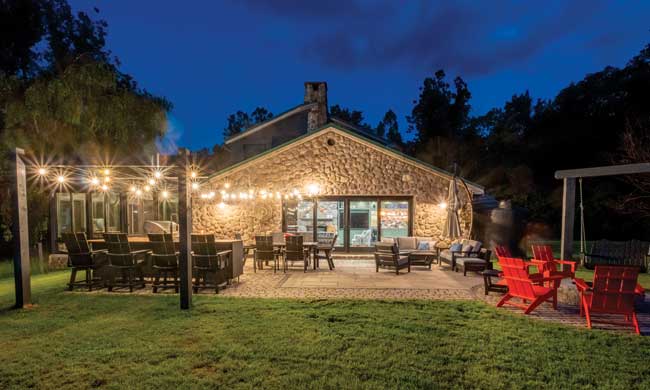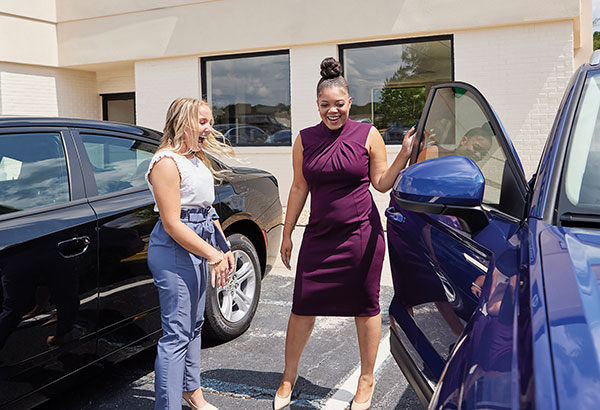Live Better
Weathering the storm

5 tips for disaster preparation
(Family Features) Over the past year, homeowners from coast to coast have experienced tussles with Mother Nature from arctic storms and heat waves to powerful hurricanes. Not only can storms wreak havoc on homes, they damage the fragile electric grid, which may result in power outages that can sometimes leave families in the dark for days or weeks.
While no amount of preparation can stop the forces of nature, planning ahead to manage blackouts can have a significant impact on you and your family. Get your home ready for what lies ahead with these tips from the Propane Education & Research Council and Anthony Carrino, a home designer, developer and contractor with more than 20 years of experience in the industry.
Outdoor Maintenance
You may not realize it, but chores like cleaning the gutters and keeping your vegetation trimmed can actually make a big difference in the event of a major storm. If your gutters are full of debris, water rushing from your roof has no place to go, and that could mean major damage to your roof, siding and even foundation.
Falling branches and trees can create a great deal of damage not only on your home but also to surrounding powerlines, which can easily break, so it’s a good idea to monitor closely for branches that could be affected by high winds and promptly remove dead trees that are especially risky in inclement weather.
If there’s time, you should also secure any outdoor furniture or belongings that could blow away or get damaged in the storm. If you have them, secure the storm shutters. It’s also a good idea to evaluate your yard’s grading at least once a year to be sure the ground slopes away from the house to keep water from pooling against your foundation.
Standby Power
Major weather events are often accompanied by extended power outages. Homeowners may turn to portable generators to turn the lights back on after the storm has passed. However, they are difficult to find and can only power a small portion of a family’s home.
Unlike a portable generator, which can power only a few appliances in a home, a propane-powered standby generator or backup generator can be a total home solution, depending on the size of the unit. When a homeowner purchases a backup generator, a licensed technician installs the unit outside of the home and wires it to the home’s electrical system. When a power outage occurs, the generator automatically senses the disruption of service and starts the generator’s engine, which then delivers power to select appliances in the home.
Propane-powered standby generators can supply supplemental electricity in as little as 10 seconds after an outage. They are available in a variety of capacities to fit the needs of any size home and can power several major appliances, including furnaces, boilers, water heaters, cooking equipment, fireplaces and clothes dryers.
For homes that already run on propane, consider running important systems and appliances like the furnace, water heater, stove and fireplace on propane so they’ll continue to run even during a power outage. The more appliances that run on propane, the smaller and less expensive your standby generator can be. Plus, propane is environmentally friendly and won’t degrade over time like some other fuel sources, ensuring the backup generator reliably powers your home to give you added peace of mind.
Home Systems
If your home is struck by a major storm, you may need to manually turn off the power, gas or water to prevent a life-threatening situation or further damage. Refresh your memory regularly on where the shut-off valves are located. If your home has a propane tank, open the lid of the tank to reveal the shut-off valve then turn it to the right to shut off the propane. If there are multiple tanks, turn them all off the same way. If possible, be certain at least two members of the family are able to perform a safe shut-off just in case someone is injured or unable to access the shut-off site. If you turn off the propane, make sure a qualified technician from your propane supplier turns the gas back on and performs a leak check. Ensuring there isn’t an issue is another step to safeguard your family after a disruption of service.
Insurance Coverage
When your home is in the path of a major storm, insurance is an important way to protect your investment. Reviewing your insurance coverage at least annually, if not every six months, can help you stay well-informed about possible exclusions and ensure you have the opportunity to increase your limits if you’ve made improvements or values have grown in your area.
An important aspect of good coverage is a thorough inventory of your possessions that details what you own and could potentially lose in a major storm. Including details like purchase price and condition may help smooth the way if you have to file a claim.
Emergency Kit
Storms can blow in fast, so having some emergency equipment you can grab in a hurry may help ease your storm response. Include flashlights, a battery-powered radio, cellphone charger and cash. You should also include first aid supplies, essential medications for everyone in the family, some nonperishable food and an adequate supply of water. Also include clothing and toiletry items, as well as supplies to care for your pets. It’s also a good idea to have copies of important records like your insurance policy, an emergency contact list and any other personal documents you may need.
By planning ahead with an emergency kit, propane-powered generator and other steps, you can put your family and home in a better position to ride it out as safely and comfortably as possible – giving you peace of mind during and after the weather-related event.
Find more ideas to help get your home storm-ready at Propane.com/Generators.
Photos courtesy of Anthony Carrino, TheBuild.tv
Live Better
Handy ways to jump start productivity in your workspace

(Family Features) Designing a project workspace can take your creativity to new heights. Whether you’re into woodworking, metalworking, building models or repairing bikes or tools like chainsaws, having the right space allows you to focus on creating and enjoying each project to the fullest.
Completing a job to your satisfaction requires the right tools, equipment and resources to get the job done. Set up a workspace that lets you explore your passion with these tips from the DIY pros at Work IQ Tools:
Identify your needs. Every project comes with a unique set of tools and requirements for success. Make a list so you can ensure you account for every detail.
- Determine if a large, flat workspace is required or floor space is better suited.
- Balance comfort and craftsmanship by choosing a stable chair or rolling chair or decide if working on your feet is more practical.
- Decide exactly how much space you realistically need.
- Assess your access to adequate power sources.
- If you’re using paints and varnish or other odorous substances, ensure there’s proper ventilation.
Invest in the right equipment. Having the right tools allows you to work faster, easier and smarter. Incorporating a solution like the IQ Vise System is like having a built-in problem solver with smart features that improve functionality and capability. The vise features a ball and socket design that allows articulation and 360-degree rotation at any angle for optimal work positioning while complementing task-specific jaws are crafted to create the perfect grip for an extensive range of shapes and materials.
Plan for storage. Keeping all your parts and pieces neatly organized means they remain in good condition until you need them, and you can find what you’re looking for easily. When you’re planning your storage needs, think about the space you need at every stage, including how you’ll protect a project that is in progress when you step away from your workspace.
Light it up. A well-lit workspace gives you the visibility you need to complete each project to your satisfaction. Overhead lights rarely do the trick for hands-on work, so plan to add task lamps to your work area. Look for models with features that match your hobby needs, such as dimming capabilities and goose necks that allow you to position the lights just right.
Remember safety. Different projects require distinct protective gear, but virtually all DIYers can benefit from some basic safety precautions. At the least, keep a first aid kit handy for nicks and cuts, but also consider safety glasses, gloves, ear protection and other gear that can help protect you while you work.
Find more useful tools to create a functional project workspace at workiqtools.com.
Workshop Assistants to Get the Job Done
No matter your craft or hobby, you can find plenty of tools and accessories that make it easier to navigate the intricate details of each project you tackle. Consider these IQ Connect plug-and-play workshop accessories that provide hands-free assistance where and when needed on the IQ Vise and around your work area via three additional mounting options.
Work Light: Task lighting helps illuminate dark or shadowed areas so you can see the tiniest details. A hands-free, 180-lumen work light that mounts in a magnetic holder, bench mount or clamp mount can add extra versatility. Rechargeable and featuring multiple light settings, it’s always ready and adaptable to your needs.
Magnifying Glass: Many hobby projects require intricately detailed work that’s difficult to see with the naked eye, whether it’s a minute piece of your project or the fine print on a tool. Look for a magnifying glass that’s at least 5 inches in diameter with at least two levels of magnification and an adjustable frame so you can get the angle just right.
Cell Phone Holder: A smartphone is often a hobbyist’s most valuable tool since you can use it to look up information, scan for design inspiration, record your process or add entertainment to your work session. An adjustable hands-free holder lets you get the positioning just right while giving you the freedom to tackle the tasks at hand.
SOURCE:
WorkIQ
Live Better
Turn your tax refund into a new ride

Make a major purchase more manageable
(Family Features) With tax refunds starting to flow in, many people are considering ways to invest their money.
If you’re looking to purchase a vehicle, putting your tax refund toward a down payment on a used car can be a smart financial decision for several reasons – from reduced interest rates on your loan and shortened loan terms to lower monthly payments – and the timing is right to take advantage of improving market conditions. Consider this information to help make an informed buying decision.
Lower Your Monthly Payment
The more you can invest in the down payment of a vehicle, the lower your monthly cost will typically be and the less interest you will typically pay over the length of the loan. This can lead to smaller, more manageable monthly payments.
A significant down payment can also help offset higher-than-average interest payments and could lead to a shorter term, meaning less total accrued interest. An auto loan calculator can show you how a down payment can affect interest charges.
More Affordable Vehicle Options Used car prices have been trending downward month-over-month, according to the Bureau of Labor Statistics’ consumer price index. These decreases in used car prices are helping offset higher than normal interest rates. The average sales price for a pre-owned vehicle through Enterprise Car Sales, for example, is approximately $21,000 right now, compared to average new car prices, which are hovering around $44,000.
Used car prices have been trending downward month-over-month, according to the Bureau of Labor Statistics’ consumer price index. These decreases in used car prices are helping offset higher than normal interest rates. The average sales price for a pre-owned vehicle through Enterprise Car Sales, for example, is approximately $21,000 right now, compared to average new car prices, which are hovering around $44,000.
Vehicle inventory is improving along with an increase in consumer demand for cars, which makes now an attractive time to buy. Many used car sellers feature inventory that is readily available so you can select from options you know are in stock, including different makes and models with a wide range of different features that can offer more affordable options.
“We have a large inventory of vehicles across the country currently priced under $20,000,” said Mike Bystrom, vice president of Enterprise Car Sales. “There are several considerations to keep in mind when shopping for a vehicle, and there is no one-size-fits-all approach. Consumers should weigh their options, but the one thing they shouldn’t compromise on is receiving great customer service.”
Protect Your Purchase
Ensuring your purchase is protected is also a smart financial decision. Take advantage of dealers that offer additional benefits to help protect your purchase and provide peace of mind that your tax refund has been well spent.
Look for a used vehicle that has passed an inspection by an ASE-certified technician and comes with a limited powertrain warranty, as well as extra coverage options such as roadside assistance and a return policy up to a certain amount of days or mileage.
With a little research and careful planning, you can find a reliable used car that meets your needs and puts your tax refund to good use. Visit enterprisecarsales.com for more information.
SOURCE:
Enterprise Car Sales
Live Better
Get ready to grill: Choosing the right outdoor cooking solution

(Family Features) Warmer temperatures and sun-filled days mean it’s time to take entertaining and socializing outdoors, and a key component of many outdoor gatherings is fresh-grilled food.
Because firing up the grill can make prepping meals quick and easy, it allows you to spend more time with friends and family rather than missing out on the sunshine while stuck in the kitchen. Whether you’re a first-time griller or consider yourself a master of the grates, there’s a grill available to meet your skill level and needs, such as these options that provide flexibility for small-to-midsize backyard spaces – as well as a large built-in model for custom outdoor kitchens – and a variety of features and function to make the most of your warm weather gatherings.

Portable, Small-Space Cooking
Ideal for first-time grillers, couples, small families or those with limited backyard spaces, the Megamaster 3-Burner Gas Grillwas designed to fuse performance and value. Despite its size, it can cater to almost any grilling or entertaining need with three stainless steel burners and 447 square inches of cooking space, a combination of versatility and capacity to prepare large quantities of food as well as various types of food simultaneously. Plus, it’s easy to maneuver on two heavy-duty wheels, making it simple to free up patio space after use. Learn more at megamaster.com.

Family-Sized Functionality
With ample cooking space to feed small and medium-sized groups, the Nexgrill 4-Burner Gas Grill with Side Burner is a perfect all-around grill for both beginners and seasoned grilling enthusiasts. Always ready to fire up some flavor, the durable grill also features a stainless steel side burner to saute, simmer and warm dishes simultaneously as well as 628 square inches of cooking space, meaning family favorites like burgers, dogs, chicken and more can be put on the table quickly. Find more information at nexgrill.com.

Elevate Your Outdoor Kitchen
If your outdoor living area includes enough space, you can elevate the outdoor cooking experience with an outdoor kitchen. Put a premium, built-in grill like the Spire 6-Burner Built-In Grill at the center of your custom, luxurious entertaining space. This dual-fuel, stainless steel gas grill features 904 square inches of cooking space and 73,000 British thermal units of cooking power across six main burners and an intense-heat ceramic rear burner, producing restaurant-quality sear marks and exceptional heat retention. Visit spireoutdoor.com to learn more about the durable, high-performance grilling solution.
SOURCE:
Megamaster
Nexgrill
Spire
-

 NEWS1 year ago
NEWS1 year ago2 hurt, 1 jailed after shooting incident north of Nocona
-

 NEWS6 months ago
NEWS6 months agoSuspect indicted, jailed in Tia Hutson murder
-

 NEWS1 year ago
NEWS1 year agoSO investigating possible murder/suicide
-

 NEWS1 year ago
NEWS1 year agoWreck takes the life of BHS teen, 16
-

 NEWS10 months ago
NEWS10 months agoMurder unsolved – 1 year later Tia Hutson’s family angry, frustrated with no arrest
-

 NEWS1 year ago
NEWS1 year agoSheriff’s office called out to infant’s death
-

 NEWS1 year ago
NEWS1 year agoBowie Police face three-hour standoff after possible domestic fight
-

 NEWS1 year ago
NEWS1 year agoDriver stopped by a man running into the street, robbed at knifepoint





